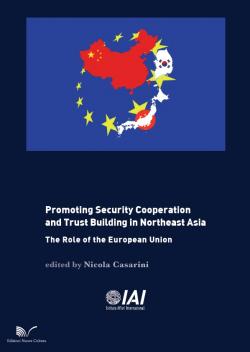Promoting Security Cooperation and Trust Building in Northeast Asia. The Role of the European Union
Questo volume intende contribuire ai dibattiti in corso sulle dinamiche in continua evoluzione della sicurezza nel nord-est asiatico, incluso il ruolo svolto dall’Ue nel promuovere la cooperazione regionale e la costruzione della fiducia. I capitoli, scritti da un gruppo selezionato di esperti europei e coreani, illustrano alcune delle iniziative sviluppate nel nord-est asiatico per promuovere la cooperazione regionale e la costruzione della fiducia. Gli autori considerano inoltre, al tempo stesso, il ruolo peculiare svolto dall’Europa nel sostenere alcune di queste iniziative, discutendo anche come – e in che misura – l’approccio dell’Ue differisca da quello degli Stati Uniti.
Risultato del progetto “Trust-building in North East Asia and the Role of the EU”, condotto dall'Istituto Affari Internazionali (IAI) con il sostegno della Korea Foundation.
List of Contributors, p. 9-10
Introduction, by Nicola Casarini, p. 11-35
1. Alternative visions of Northeast Asia
2. Europe’s concern for Northeast Asia’s security
3. The EU’s new capabilities
4. The scope of this book
Part I. Assessing Regional Order: The Perspectives of China, Japan and South Korea
1. Northeast Asia’s Evolving Security Order: Power Politics, Trust Building and the Role of the EU, by Elena Atanassova Cornelis, p. 39-50
1. Northeast Asia’s strategic uncertainties
2. Competitive security dynamics
3. Cooperation and trust building
4. Approaches to regional order
Conclusion
2. China’s Foreign Policy in Northeast Asia: Implications for the Korean Peninsula, by Silvia Menegazzi, p. 51-61
1. Chinese interests in Northeast Asia
2. China’s response to Pyongyang’s nuclear strategy
3. Reactions towards Korean Peninsula unification
Conclusion and Recommendations
3. Japan’s Approach to Northeast Asian Security: Between Nationalism and (Reluctant) Multilateralism, by Axel Berkofsky, p. 63-74
1. Constitutional reinterpretation and national-security laws
2. The problem with Japanese nationalism and revisionism
3. (A degree of) Japanese-Korean reconciliation
4. Japanese security policies: defensive-oriented, bilateral and multilateral
5. Japan and NAPCI
Conclusions
4. Trust Building and Regional Identity in Northeast Asia, by Nam Kook Kim, p. 75-93
1. Two principles of trust building in Northeast Asia
2. The “Asian paradox” and East Asian regional integration
3. The Abe statement and inherited responsibility
4. The Helsinki Accords and the multilateral security-cooperation regime in East Asia
5. The possibility of an Asian Court of Human Rights
6. The Campus Asia programme and sociocultural cooperation
Conclusion
Part II. Evolving Security Dynamics on the Korean Peninsula
5. Assessing North Korea’s Nuclear and Missile Programmes: Implications for Seoul and Washington, by Lorenzo Mariani, p. 97-116
1. The Byungjin policy and its strategic success
2. The growing nuclear threat
3. The missile programme
3.1 Hwasong-6
3.2 Nodong
3.3 Musudan
3.4 Taepodong
3.5 Pukkuksong-1
4. What options for South Korea and the United States?
Conclusion
6. Wither the Inter-Korean Dialogue? An Assessment of President Park’s Trustpolitik, by Antonio Fiori, p. 117-136
1. To trust or not to trust: that is the question
2. Park Geun-hye’s Trustpolitik
3. Seoul proactivity: “Waiting for Godot”
Conclusion
7. NAPCI and Trilateral Cooperation: Prospects for South Korea-EU Relations, by Si Hong Kim, p. 137-149
1. NAPCI: Past achievements and future prospects
2. NAPCI and trilateral cooperation
3. The EU and ASEAN as reference for NAPCI
4. Implications for South Korea-EU relations
Conclusion
Part III. The Added Value of the EU for Security and Trust Building in Northeast Asia
8. The EU and the Korean Peninsula: Diplomatic Support, Economic Aid and Security Cooperation, by Ramon Pacheco Pardo, p. 153-167
1. Background
2. Diplomatic support for the ROK and multilateral peace efforts
2.1 The EU and President Park’s Trustpolitik and NAPCI
2.2 The EU and a resumed Six-Party Talks mechanism
3. Economic engagement with the DPRK
3.1 Aid and assistance
3.2 EU-funded development projects
4. Security cooperation with the ROK and other partners
4.1 Non-proliferation of WMD and DPRK denuclearization
Policy Recommendations
9. The EU and the Six-Party Talks, by Moosung Lee, p. 169-181
1. Evolution of the Six-Party Talks
2. The EU’s contributions to the talks
3. The limits of the EU’s engagement
Conclusion
10. Supporting NAPCI and Trilateral Cooperation: Prospects for Korea-EU Relations, by Michael Reiterer, p. 183-193
1. The EU’s commitment to Asia in the light of the security landscape in Northeast Asia
2. A review of NAPCI
3. NAPCI: progress achieved
4. The way forward
Conclusions
Bibliography, p. 195-221
Tema
Tag
Contenuti collegati
-
Ricerca22/03/2016
Trust-building in North East Asia and the role of the EU
leggi tutto




